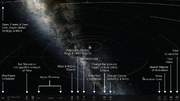This page is an overview of the user interface (UI) in Universe Sandbox. It is meant to describe the general purposes of different parts of the UI and help in finding different settings and controls.
The UI in Universe Sandbox changes often with updates, so not everything may be exactly as it appears in the latest version.

Home
New
Create a new, blank simulation.
This is the first step in building a simulation from scratch. See Getting Started for more information.
Save the current simulation as a custom simulation, or share on Steam Workshop. Saved simulations can be found in Home > Open > My Sims.
Open
Browse a list of included simulations.
Settings
Adjust general game settings, like Graphics settings, Audio settings, and Performance Settings. These settings are global and will persist when a new simulation is loaded. For simulation-specific settings, see View Settings and Sim Settings below.
Guides
Browse a list of guided simulations.
Exit
Close Universe Sandbox.
Workshop
Browse simulations created by other users on the Steam Workshop.
Bottom Bar
Play/Pause Button
Pause a running simulation or a play a paused simulation. This can also be controlled with the Spacebar on a keyboard.
Date and Time
This displays the current date and time in the simulation. When clicked, it opens the Time Zone setting.
Timer
Allows the user to run the simulation until a certain time or date, at which point the simulation will pause or change its Time Step.
Step
The Step menu contains additional time step settings and controls, including the Target Time Step, and the Advance One Time Step, Reload Simulation, and Pause on Collide controls.
Time Step
Displays the simulation Time Step, which can be adjusted using the slider or by entering a value in the text box with the keyboard.
Edit
Allows the user to adjust the position, rotation, and velocity of a selected object or objects.
Add
Adds a new object to the simulation.
Tools
Provides access to several tools for manipulating the simulation:
- More
- Opens the full Sim Actions Menu
- Fly
- Sends the camera to the selected object
- Explode
- Delete
- Removes the selected object from the simulation.
- Force
- Applies a cone-shaped force extending from the cursor's position.
- Pulse
- Launches a ring of particles from the position of the selected object.
- Fireworks
- Launches fireworks from the selected object.
- Material
- Launches a stream of particles from the cursor, made up of a given material.
- Laser
- Fires a laser from the cursor, forward from the camera.
- Launch
- Adds a body to the simulation with the Launch setting.
Chart
Rearranges the objects in the simulation to be ordered according to size or mass.
View
These settings affect only the currently opened simulation.
- Settings
- Opens the full View Settings Menu
- Labels
- Toggles object labels on or off
- Trails
- Toggles displayed trails on or off
- Orbits
- Toggles displayed orbits on or off
- Habitable
- Displays or hides the habitable zones of stars
- Grid
- Displays or hides the Simulation Grid
- Background
- Changes the background of the simulation.
- Light
- Changes the lighting of the simulation.
- Colors
- Changes the colors of objects and their trails, labels, and icons to represent the relative strength of velocity, acceleration, or mass compared with other objects in the simulation.
- Surface
- Enables experimental Surface View feature
Sim
These settings affect only the currently opened simulation.
- More
- Opens the full Sim Settings Menu
- Collide
- Toggles whether or not objects collide. If turned off, objects will pass through each other instead of colliding.
- Fragment
- Toggles creation of fragments, which can be caused by collisions, Roche limit fragmentation, and friction fragmentation from explosions. Also toggles creation of volatiles from extreme heats and solar winds.
- Gravity
- Changes the strength of the Gravitational Constant.
- Heating
- Changes the Heat Diffusion Rate in the simulation.
Stats
Displays statistics about the currently opened simulation:
- Object Count
- The total number of objects in the simulation
- Simulated
- The number of objects being actively simulated
- Non-Simulated
- The number of suspended objects not being actively simulated
- Attracting
- The number of attracting objects exerting a gravitational force
- Non-Attracting
- The number of objects not exerting a gravitational force
- Decals
- The number of impact decals used in the simulation
- Star Count
- The number of Star objects in the simulation
- Mass
- The total mass of all objects in the simulation
- Velocity
- The magnitude of the sum of the Velocity Vectors of all objects in the simulation
- Momentum
- The magnitude of the sum of the Momentum Vectors of all objects in the simulation
- Mass Lost
- The total amount of mass lost to the simulator during the simulation
- Momentum Lost
- The total amount of momentum lost to the simulator during the simulation
Search
Displays all objects in the currently opened simulation. Clicking one of the objects in the Search menu will focus the camera on that object.
Objects are sorted into tabs according to their object types, including Stars, Planets, Moons, Minor, Misc, Galaxies, and Black Holes. There is a text box for searching all simulation objects by name.
Video
Tools and settings for capturing video.
Photo
Tools and settings for taking screenshots.
Object Properties Panel
Right-clicking an object in the simulation will open the object's properties panel, which will include one or more tabs displaying properties specific to that object. These tabs can include:
